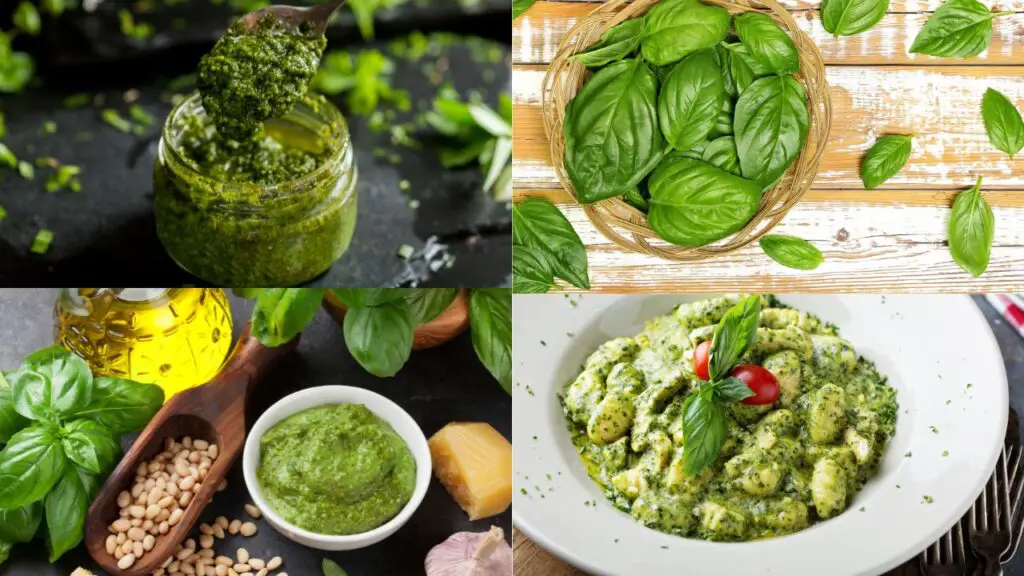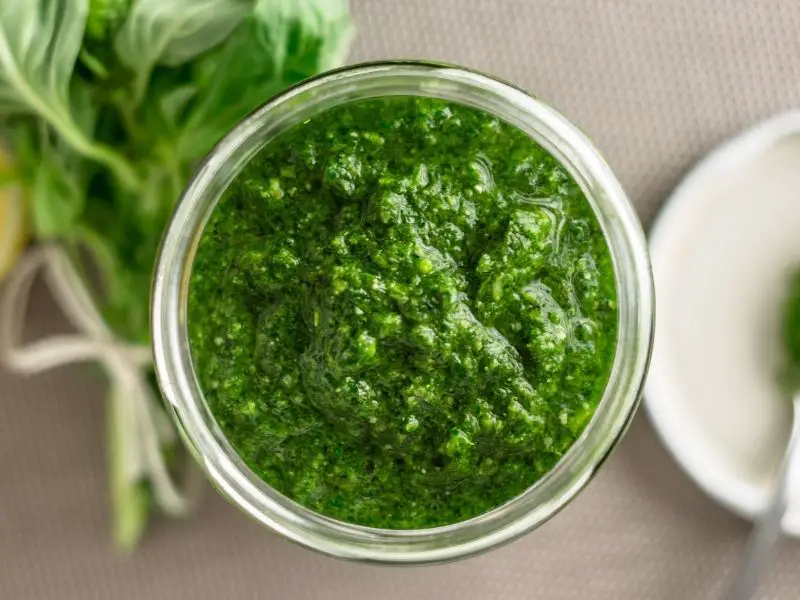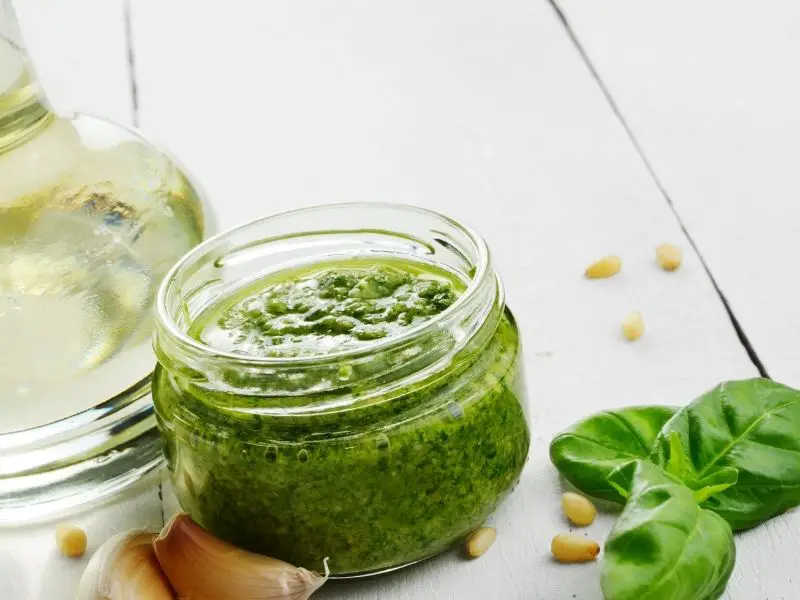How To Make Basil Pesto + Alternative Variations
Ever wondered what makes that green sauce so irresistible? Yep, I’m talking about basil pesto. This magical concoction transforms any dish into a gourmet experience, and guess what? It’s ridiculously easy to make at home. No need to be an Italian grandma to whip up a batch of this deliciousness.
Essential Ingredients for Basil Pesto
Making basil pesto at home is easy when you have the right ingredients. Here’s what you’ll need to whip up a batch of fresh, delicious basil pesto.

Fresh Basil
Fresh basil is the star of the show. You’ll need about 2 cups of packed fresh basil leaves. Make sure they’re vibrant green and free from blemishes. Fresh basil provides the essential herbaceous flavor that sets pesto apart.
Pine Nuts
Pine nuts give pesto its rich, buttery texture. Use 1/4 cup of pine nuts. Lightly toast them in a dry skillet for an extra layer of flavor. Though expensive, they’re worth it for authentic pesto.
Parmesan Cheese
Parmesan cheese adds a savory, umami punch. Grate 1/2 cup of fresh Parmesan cheese. Avoid pre-shredded varieties, which often contain additives. Use authentic Parmigiano-Reggiano for the best taste.
Garlic
Garlic gives basil pesto its aromatic intensity. Use 2-3 cloves of garlic. Crush or finely chop them to release their oils. Fresh garlic can sometimes be strong, so adjust to your taste.
Olive Oil
Olive oil binds everything together. Use 1/2 cup of good quality extra-virgin olive oil. It provides a smooth texture and enhances the flavors. Drizzle it slowly while blending to achieve the perfect consistency.
Step-by-Step Guide to Making Basil Pesto
Making basil pesto at home is straightforward if you follow these steps. Let’s get started.
Preparing the Ingredients
First, gather fresh basil leaves, pine nuts, Parmesan cheese, garlic, and olive oil. Rinse the basil leaves under cold water to remove any dirt, then pat them dry with a paper towel. Toast the pine nuts lightly in a skillet over medium heat for 3-4 minutes, stirring frequently to avoid burning. Grate the Parmesan cheese finely. Peel the garlic cloves, and chop them coarsely.
Blending the Ingredients
Place the basil leaves, toasted pine nuts, grated Parmesan, and chopped garlic in a food processor. Blend the mix until it forms a coarse paste. Gradually add olive oil through the processor’s feed tube while continuing to blend. Blend until the mixture reaches a smooth, creamy consistency.
Adjusting Consistency and Flavor
To adjust the pesto’s consistency, add more olive oil for a thinner sauce or more Parmesan cheese for a thicker texture. Season the pesto with salt and pepper to taste. For extra zest, add a squeeze of lemon juice. Blend briefly to mix the added ingredients evenly.
Variations of Basil Pesto Recipe

Nut-Free Alternatives
For nut-free basil pesto, sunflower seeds or pumpkin seeds can replace pine nuts. Sunflower seeds offer a mild flavor, while pumpkin seeds add an earthy touch. Toast them lightly before blending to enhance their taste. Keep other ingredients as they are to retain the classic pesto flavor.
Vegan Substitutions
To make a vegan basil pesto, swap Parmesan cheese with nutritional yeast. Use the same quantity for a cheesy, nutty flavor. Also, select a good-quality extra-virgin olive oil and combine it with garlic, basil, and pine nuts or seeds for nut-free options.
How to Store and Preserve Basil Pesto
Proper storage extends the life of basil pesto and maintains its fresh, vibrant flavor.

Refrigeration Tips
Keep basil pesto in an airtight container to prevent oxidation. Fill the container almost to the top, leaving little air space. Pour a thin layer of olive oil over the surface to create a barrier against air and light. Store it in the refrigerator, where it stays fresh for up to one week.
Freezing for Long-Term Storage
For longer preservation, freeze basil pesto. Spoon it into ice cube trays, then freeze until solid. Transfer the frozen cubes into a zip-top bag. Each cube equals about one tablespoon, making portioning easy. In the freezer, pesto remains good for up to six months. Thaw it in the fridge overnight or at room temperature for quicker use.
Innovative Ways to Use Basil Pesto
Basil pesto’s versatility makes it an exciting addition to many dishes. Incorporating it creatively enriches the flavor profile significantly.

As a Pasta Sauce
Tossing pasta with basil pesto creates a quick, flavorful meal. Use it on spaghetti, penne, or fusilli for satisfying results. Mix it with heavy cream for a richer sauce or add roasted vegetables for a healthier twist. For a balanced dish, top with grilled chicken or shrimp.
In Sandwiches and Wraps
Spread basil pesto on sandwiches and wraps to elevate ordinary lunches. Pair it with turkey, mozzarella, and tomatoes for a classic combination. Try it with grilled vegetables and feta cheese for a vegetarian option. The pesto adds moisture and flavor without the extra calories of other condiments.
As a Dip or Spread
Use basil pesto as a dip for vegetables, crackers, or bread. It serves as a delightful alternative to hummus or ranch. Blend it with Greek yogurt for a lighter option. Pesto also works well as a spread on bruschetta or as a topping for baked potatoes, enhancing the dish with its vibrant taste.